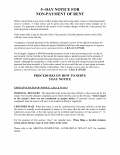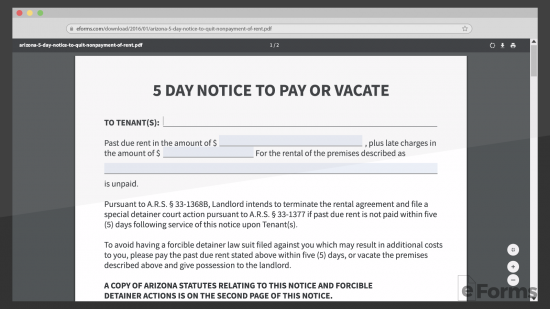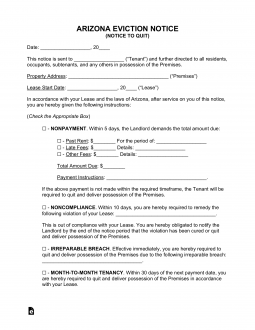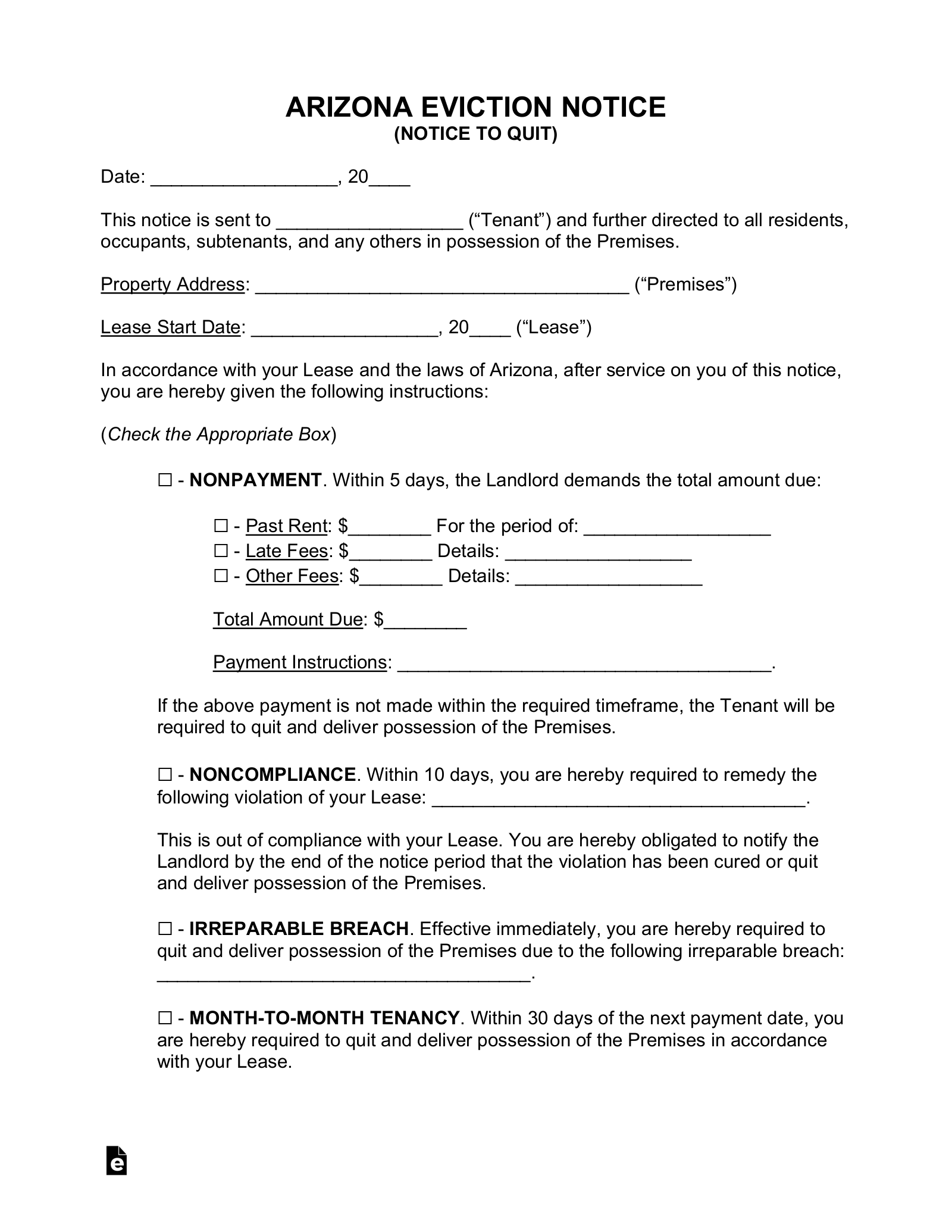Updated January 08, 2024
An Arizona eviction notice is a document a landlord uses to inform the tenant of a lease violation and a certain number (#) of days to either fix or vacate the premises. If the tenant does neither, the landlord may pursue legal action in their local court.
By Type (4)
 5-Day Notice (Non-Payment of Rent) – Informs the tenant that their rent is in arrears and that they have five days to pay what is owed or move out of the property. 5-Day Notice (Non-Payment of Rent) – Informs the tenant that their rent is in arrears and that they have five days to pay what is owed or move out of the property.
Download: PDF |
 10-Day Notice to Quit (Non-Compliance) – This form provides notice to the tenant that they are in breach of a material provision in the lease and that they have ten days to remedy the breach or vacate the property. 10-Day Notice to Quit (Non-Compliance) – This form provides notice to the tenant that they are in breach of a material provision in the lease and that they have ten days to remedy the breach or vacate the property.
Download: PDF |
 Immediate Notice (Irreparable Breach) – This form informs the tenant that they have breached the lease and must leave the premises immediately. Immediate Notice (Irreparable Breach) – This form informs the tenant that they have breached the lease and must leave the premises immediately.
Download: PDF |
 30-Day Notice to Quit (Month-to-Month Tenancy) – This form is used to inform a tenant under a lease of notice of termination of the lease within 30 days of the notice. It gives the tenant 30 days to leave the property. 30-Day Notice to Quit (Month-to-Month Tenancy) – This form is used to inform a tenant under a lease of notice of termination of the lease within 30 days of the notice. It gives the tenant 30 days to leave the property.
Download: PDF |
Table of Contents |
Prohibited Landlord Actions
Court Forms
Answer (LJEA00004F) – The tenant uses this form to either admit or deny the allegations made against them. The form is to be duplicated and filed with the court clerk along with the filing fee.
Complaint (AOC LJEA2F) – The Complaint form is to notify the tenant, following the delivery of a written notice, that the landlord is suing them. A copy of the complaint should be delivered to the court and served on the tenant.
Summons (AOC LJEA1F) – The Summons form is used to notify the tenant that they are summoned to the court on the specified date. This should be delivered to the tenant along with the complaint form.
Residential Eviction Information Sheet (REIS) – The REIS can be served along with the complaint and summons to provide the tenant with the information necessary to admit to or reject the claims against them.
Writ of Restitution – A document applied for by the landlord and served on the tenant by a constable who will direct the tenant to vacate the property.
How to Evict a Tenant (6 steps)
- Give Notice to the Tenant
- Wait for the Tenant
- File with the Court
- Serving the Tenant (Before the Court Hearing)
- Appearing in Court
- Serve the Writ of Restitution
1. Give Notice to the Tenant
 Before any filings are made with the court, the landlord must provide written notice to the tenant that the eviction process has begun. Use the eviction notice that best matches the tenant’s violation:
Before any filings are made with the court, the landlord must provide written notice to the tenant that the eviction process has begun. Use the eviction notice that best matches the tenant’s violation:
- Notice of Irreparable Breach
- 5-Day Notice (Non-Payment of Rent)
- 10-Day Notice to Quit (Material Non-Compliance)
- 30-Day Notice to Quit (Month to Month)
Delivery – A landlord can deliver an eviction notice if it is delivered by hand or through certified mail. If mailed, the tenant is considered to have received notice on the date of receipt of 5 days after the address mentioned for communications in the lease agreement.[11]
2. Wait for the Tenant
 The landlord must wait for the notice period to see if the tenant responds to either remedy the violation or make the rental payment that is due. The landlord is authorized to proceed with the eviction process in court if the tenant does not cure the violation or respond 1 business day after the notice is delivered.[12]
The landlord must wait for the notice period to see if the tenant responds to either remedy the violation or make the rental payment that is due. The landlord is authorized to proceed with the eviction process in court if the tenant does not cure the violation or respond 1 business day after the notice is delivered.[12]
3. File with the Court

The landlord must file the following forms with the court:
- Lease agreement (incl. addendums);
- Complaint (AOC LJEA2F) – 3 copies (4 copies if two tenants);
- Summons (AOC LJEA1F) – 3 copies (4 copies if two tenants);
- 6-months of payments (conditional) – If for late rent, the landlord must present receipts of all payments made by the tenant in the last 6 months.[13]
The filing fee depends on the county and is commonly between $35 to $110. For example, the following counties are as follows:
4. Serving the Tenant (Before the Court Hearing)

After the landlord files an eviction with the court, the clerk will give a court hearing date. The landlord must inform the tenant of the action filed against them by sending the following filed forms:
- Complaint (copy of filing)
- Summons (copy of filing)
- Answer
- Residential Eviction Information Sheet (REIS)
The above forms must be sent by a constable, sheriff, or licensed process server at least 2 days before the court hearing date.[19]
5. Appearing in Court
 All parties must appear on the court hearing date. The landlord should bring a copy of the Judgment for the Judge to sign if the eviction is approved.
All parties must appear on the court hearing date. The landlord should bring a copy of the Judgment for the Judge to sign if the eviction is approved.
If the eviction is for non-payment of rent (only), the tenant has the option to reinstate their lease if they pay all back rent, penalties, court costs (for the landlord), and attorney’s fees prior to the Judgment being signed.[20]
If the Judgment is signed and the landlord wins their case, the tenant will have 5 days to remove themselves from the property.
6. Serve the Writ of Restitution

If the tenant has not moved out of the property within 5 days from the Judgment being signed, the landlord can file a Writ of Restitution. If approved, the landlord can deliver the signed Writ of Restitution to the local Sheriff or constable to serve the tenant.[21]
If the tenant remains on the property after being served the Writ of Restitution and without the landlord’s consent, they could be charged with criminal trespass.
Sources
- A.R.S. § 33-1314(C)
- A.R.S. § 33-1368(A)(2)
- A.R.S. § 33-1368(A)(2)
- A.R.S. § 33-1368(A)(2)
- A.R.S § 33-1375(B)
- A.R.S. § 12-1171
- A.R.S. § 33-1324(4)
- A.R.S. § 33-1367
- A.R.S. § 33-1362
- Arizona Tenants’ Rights and Responsibilities Handbook (Page 13)
- A.R.S. 33-1313(b)
- www.azcourts.gov/legalinfohub/Legal-Process-Sheets/Eviction-Actions
- www.azcourts.gov/legalinfohub/Legal-Info-Sheets/Landlord-Tenant-Disputes-amp-Eviction/Non-Payment-of-Rent#Complaint
- www.justicecourts.maricopa.gov/about-us/justice-court-fees
- www.mohavecourts.com/filing-fees
- www.jp.pima.gov/Forms/Forms.html
- www.pinalcourtsaz.gov/192/Filing-Fees
- www.courts.yavapaiaz.gov/verdevalleyjc/fee-schedule
- www.azcourts.gov/legalinfohub/Legal-Process-Sheets/Eviction-Actions
- A.R.S. § 33-1368(B)
- www.azcourts.gov/legalinfohub/Legal-Info-Sheets/Landlord-Tenant-Disputes-amp-Eviction/After-an-Eviction-Judgment


